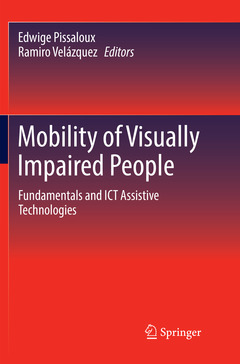Mobility of Visually Impaired People, Softcover reprint of the original 1st ed. 2018 Fundamentals and ICT Assistive Technologies

Edwige Pissaloux is a Full Professor at the University of Rouen, Physics Department, and closely collaborates with the ISIR (Institute for Intelligent Systems and Robotics) at Paris-Sorbonne University and the MIT (France-MIT program). She has authored more than 250 journals and conferences papers. Prof. Pissaloux main research interests are the modeling and design of vision systems, cognitive perception systems, and cognitive mobility systems.
Her research has been supported by European funds (EU FP7 Research and Innovation Funding Program), national funds (CNRS, CEA), and international projects (France-UK-Mexico). Prof. Pissaloux is a member of several international advisory boards of universities and research institutes, and teaches in several universities (Australia, Hong-Kong, Canada). She frequently acts as an international expert for several research bodies and international institutions such as the European Commission, NSF/USA, Canada, UK, Australia, China, Switzerland, etc.Prof. Pissaloux initiated a series of national conferences such as “Space and its perception: application to design of assistive technologies” or “Eye, gaze and interaction”. She has participated and/or co-animated European Excellence networks.
In her free time, Prof. Pissaloux teaches violin for visually impaired children.
Ramiro Velázquez is an Associate Professor at the Faculty of E
ngineering of Universidad Panamericana (Aguascalientes, Mexico). He is past Dean of the Faculty of Engineering and currently serves as Vice-President for Research and member of the Board of Governors of this university.He obtained the PhD in Robotics from UPMC-Paris6 Sorbonne University in 2006. He has authored more than 100 journals and conferences papers. Prof. Velázquez main research interests are assistive technologies, haptic and tactile devices, mechatronic systems, and human-computer interaction. His research projects in assistive devi
Date de parution : 08-2018
Ouvrage de 652 p.
15.5x23.5 cm
Date de parution : 09-2017
Ouvrage de 652 p.
15.5x23.5 cm
